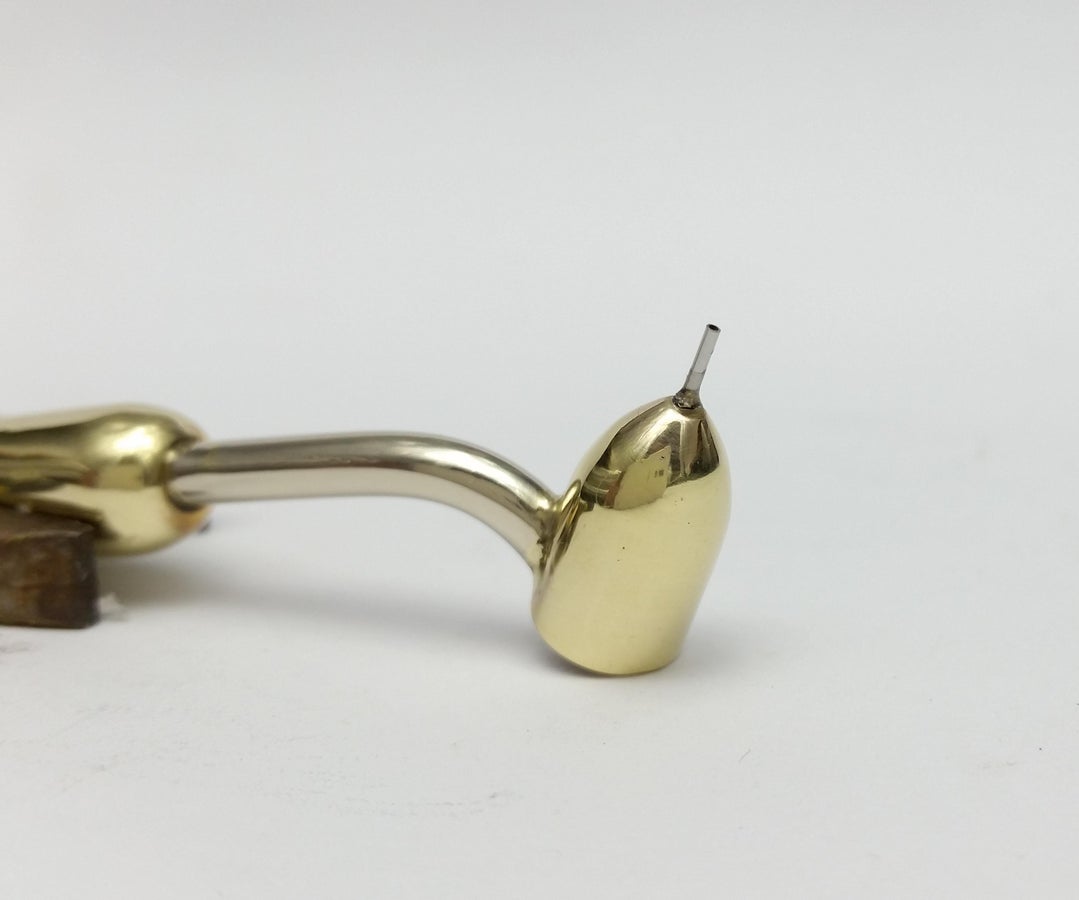Introduction: Make Your Own Fine Paint Pen From Scratch!
Hello fellow makers,
I recently saw a clip on my Instagram timeline of a person repairing a scratch on a car using fine line paint pen, it was the first time I saw a pen like this and I had to have one!
Being a maker I simply couldn't just go online and buy one I had to make one so I jumped into my treasure chest (aka junk drawer) and pulled out a few pieces I could transform into my own paint pen.
The fine line paint pen is a metal tool that holds paint or ink in a small reservoir. It allows you to draw, paint, or write in the same manner as a pen while creating a beautiful, fine painted line. Works well with thinned acrylic or solvent based paints.
In this Instructable I make use of bits and bobs I had laying around but everything I used can easily be substituted and I will give some alternatives too.
![]()
If you enjoy my Instructables and would like to support my future projects you can Buy Me A Coffee.
Step 1: What You Will Need:
To make your own paint pen you will need the following:




- 2x .223/9mm spent cartridge OR 10mm brass tubing
I chose the .223 because it has a thicker wall
Amazon - Brass Round Tube, 300mm Length 10mm OD 0.2mm Wall Thickness
- Syringe needle according to the tip thickness you want
I prefer in the 21 gauge range
- 4mm Brass rod
Amazon - 8 PCS 4mm/ 5/32 Inch Brass Rod
- Silver solder
Amazon - 2 Pack 56% Silver Solder Flux Covered Rod
- Butane torch
- 2 Part CA glue
Amazon - MITREAPEL Ca Glue with Activator (2 x 1.7 oz - 2 x 6.7 fl oz)
- 0.8mm Drill bit
Amazon - 20 Pcs 0.8 mm HSS Micro Twist Drill Bit
- Wooden handle




Optional:
- Diamond cut-off disk for Dremel
Amazon - Diamond Cutting Wheel (22mm) 25pcs
*As an Amazon Associate I receive a small percentage from sales made through provided links at no cost to you, this helps fund future projects.
Step 2: Making the Paint Cup:
First step is to make the paint cup for the pen, as I do not have access to a lathe I did all of the metal shaping on my bench drill.

I started by placing the spent .223 cartridge in my drills chuck, to prevent the jaws from disforming the tube when tightening I inserted a dowel inside of the cartridge.
Using a flat file I rounded off the rim of the case, unfortunately we can't round off the end completely as we risk going through the case.

In order to complete the point of the cup we will need to add some additional material, I'm using a piece of 4mm brass rod and by using the drill and file again I shape it into a point with cylinder that fits inside of the primer hole of the spent bullet case.

You want the solid point of your cup to be as long as possible because this will be supporting the painting tip, don't worry if the point and case don't match up perfectly as we can simply shape it in the drill again after soldering.
Step 3: Solder and Drill the Paint Cup:
Time to solder the paint cup together and finish it off.
I clamped the open end of the case in some pliers and then using a propane torch I soldered the tip onto the casing using silver solder, you don't have to worry about overflowing solder just make sure to fill in all the gaps between the case and tip.
After soldering let the piece cool completely and then we can place it back into the drill and do some final shaping with the file.

When you're done shaping it you can use the edge of the file to cut the cup to length this gives you a nice straight cut with a 45 degree bevel and the pressure creates a very slight lip on the inside that will help eliminate paint spills.
My paint cup is about 15mm long but you can increase this length to hold more paint but I wouldn't go much longer as it could cause leaking with thinner paints.

To finish the cup we simply need to drill a hole through the tip with a 0.8mm drill bit, this will fit points up to 21 gauge.
I used a PCB drill fitted in my Dremel turning the cup as I drilled to get as straight of a hole as possible, If your hole is skew you can simply enlarge it a bit or fill it with some solder.

Step 4: Making the Metal Components for the Handle:
With the paint cup finished we can move on the handles components.
The cup of the handle is made from a spent 9mm casing, I chose the 9mm because of the thinner walls it can easily be shaped for a snug fit around your handle.
The rim of the 9mm cartridge was also rounded off with a file in the drill like we did with the paint cup.
A piece of 4mm brass rod left over from a previous project fits perfectly inside of the primer hole of the casing to give a neat finish.

- Wear leather gloves when working with hot metal! -
Using the propane torch heat up a spot on your 4mm brass rod and bend it about 80 degrees and leave to cool.
Measuring 20mm from the bend cut off the excess metal from one side, now we can solder this cut side onto the 9mm casing as pictured below.

TIP: You can leave your metal parts in some spirit vinegar to get rid of any flux left over from soldering.
Step 5: Finish the Metal Components:
Time to join the handle components with the paint cup.
First we need to solder the handle part onto the painting cup but before that we will need to cut off the excess of the 4mm brass rod.
For the length I wanted I cut the rod just after the bend at a 45 degree angle as pictured, you want this angle so that the rod sits flat against the paint cup for soldering.

Be careful when soldering to concentrate the heat on the side of the painting cup where the handle will attach otherwise you risk melting the solder of the tip.
Once you're done soldering you can pickle the entire metal part in some vinegar to get rid of the flux from the silver solder before moving on to polishing.

Using some 400 grit sanding paper I sanded away all of the staining and imperfections left after soldering before giving it a buff with some fine steel wool.
Next I moved over to the drill again this time with a cotton polishing wheel and a fine compounding block for brass to give our creation a beautiful shine.

To complete the metal component of the build we need to refine the inside of the painting cup, to ensure a constant flow and easier clean-up we need to smooth out the inside.
Using a 3mm drill bit I gave the 0.8mm drilled hole a few turns by hand on the inside to create a "funnel" to eliminate any burrs and ridges that can impede flow, next using a rubber compounding bit in my Dremel I polished the inside to ensure a smooth even surface.

Step 6: The Handle:
Giving the pen a handle.
The handle can be made out of anything you desire or have lying around but as I have multiple old frayed brushes that still have perfectly good handles albeit a bit dirty this seemed like the perfect solution.
I selected this wooden handle that was roughly the diameter I needed, I cut off the old connection point and whittled the end to fit into the 9mm case sleeve.
The handle simply needed a good sanding with 220 grit sanding paper to bring it back to it's former glory.

Step 7: The Paint Tip:
Next we need to add a tip to the paint cup.
Before cutting run the tip of the syringe against some concrete to dull the tip for safety.
With a diamond cutting disk in your Dremel cut off a 10mm piece of the syringe, once cut run the two ends on some 400 grit sanding paper in a circular motion to remove cutting burrs and give you a smooth glide.

To attach the tip into the paint cup we are going to use 2 part CA glue, this will give us a sturdy, leak proof and chemical resistant bond but you can still change out the tip by simply heating up the bond with a lighter.
Simply add a small bead of adhesive around one half of the tip and insert into the hole of the painting cup, make sure it is straight and flush on the inside before spraying some activator to cure the glue.

Step 8: Finishing Your Paint Pen:
Finally we can attach our handle and give it a protective coat.
We will also be using 2 part CA glue to attach the wooden handle, simply add a few drops of the CA glue inside of the metal sleeve, spray some activator on the wooden handle and press the two parts together.
To finish the build off I gave the wood a good feeding of linseed oil for protection against the paint and solvents that will be used.

Step 9: Enjoy!
Now we can start using our paint pen, simply add a few drops of thinned paint (viscosity of a thin oil) into the cup and you're off.
I've even tested the pen at 90 degrees and it works without spilling I can even lay it down flat without any paint escaping the secret is to never fill up the cup all the way and to get the perfect viscosity, too thin and it will drip out of the tip, too thick and you won't get good flow.
I hope you guys find this Instructable useful and if you have any questions please feel free to leave me a message or comment bellow.
Thank you for taking the time to read through my project and as always..
Happy making!
---

Second Prize in the
Metal Contest













